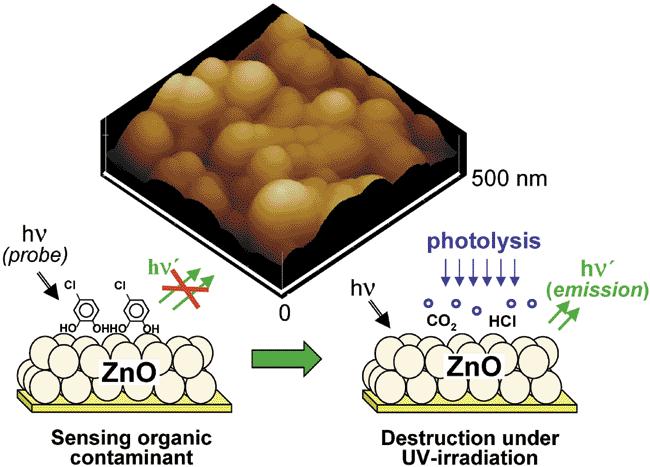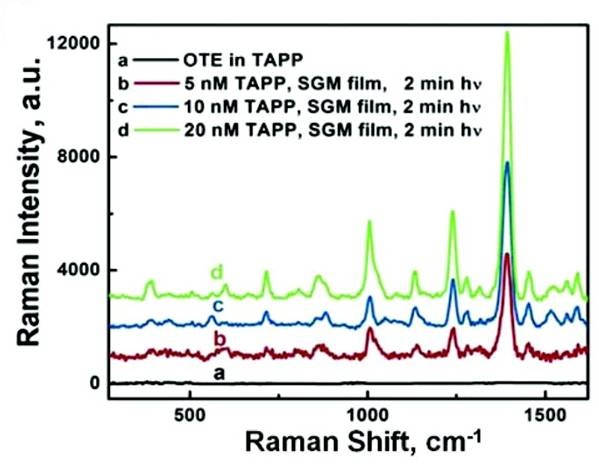Chemical Sensors
Background

Figure. ZnO nanostructured film for detection of environmental contaminant via fluorescence quenching and degradation of the contaminant via photocatalytic oxidation.
Development of chemical sensors is of interest for detecting a vast array of targets such as chemical warfare agents, environmental contaminants, and explosive materials. High sensitivity as well as selectivity are ideal characteristics for a sensor material. Surface enhanced Raman scattering (SERS) active materials are capable of sensing molecules at very low concentration. A current research aim of our lab is to develop sensors capable of both detection of trace contaminants as well as degradation of the contaminants via photocatalytic processes.
Check out these links for more info!
- Electron hopping in graphene oxide leads to highly sensitive sensing - Phys Org article highlighting the semiconductor-graphene-metal (SGM) composite developed in our lab
- Surface Enhanced Raman Spectroscopy (SERS) - Learn more about SERS with this Wikipedia article on the sensing technique
Our Research Focus
- Development of low-cost selective sensors
- Improving the detection limit to sub-nanomolar regime
- Films effective for both sensing and destruction of target molecules via photocatalytic degradation
Recent Progress
- Pioneered a solution-based method for the formation of "holey" graphene with potential benefits to sensing as well as other fields
- Developed SGM films capable of low nM detection
- Demonstrated "Sense and Shoot" capability of ZnO nanostructure films capable of ~1 ppm detection of 4-chlorocatechol and photocatalytic degradation of the same contaminant

Figure. Depicts fabrication of semiconductor-graphene-metal (SGM) film used for nM SERRS sensing (left). SERRS spectra of tetra(4-aminophenyl) porphyrin (TAPP) at 5 nM – 20 nM concentration acquired using SGM film (right).
Select Publications
439. Making Graphene Holey. Gold-Nanoparticle-Mediated Hydroxyl Radical Attack on Reduced Graphene Oxide Radich, J. G.; Kamat, P. V. ACS Nano 2013, 7 (6), 5546–5557.
434. Reduced Graphene Oxide–Silver Nanoparticle Composite as an Active SERS Material. Murphy, S.; Huang, L.; Kamat, P. V. J. Phys. Chem. C 2013, 117 (9), 4740–4747.
431. Graphitic Design: Prospects of Graphene-Based Nanocomposites for Solar Energy Conversion, Storage, and Sensing. Lightcap, I. V.; Kamat, P. V. Acc. Chem. Res. 2013, 46 (10), 2235–2243.
426. Electron Hopping Through Single-to-Few Layer Graphene Oxide Films. Photocatalytically Activated Metal Nanoparticle Deposition. Lightcap, I. V.; Murphy, S.; Schumer, T.; Kamat, P. V. J. Phys. Chem. Lett. 2012, 3, 1453–1458.
294. The Selective Electrochemical Detection of Model Pollutant Species Using Films of Naturally Occurring Humic Acid K. Environ. Vinodgopal, K., V. Subramanian, and P.V. Kamat Sci. Technol. 2004, 38, 2161-2166 NDRL 4471
287. Nanoscience Opportunities in Environmental Remediation. Kamat, P.V. and D. Meisel Comptes Rendus Chimie 2003, 6, 999-1007. NDRL 4443 (Review Article)
262. A Sense and Shoot Approach for Photocatalytic Degradation of Organic Contaminants in Water. Kamat, P. V.; Huehn, R.; Nicolaescu, R. J. Phys. Chem. B 2002, 106, 788-794. NDRL 4307
244. Combinative Sonolysis and Photocatalysis for Textile Dye Degradation. Stock, N.L., Peller, J., Vinodgopal, K.Kamat, P.V., Environ. Sci. & Technol. 2000, 34(9), 1747-1750. NDRL 4177
